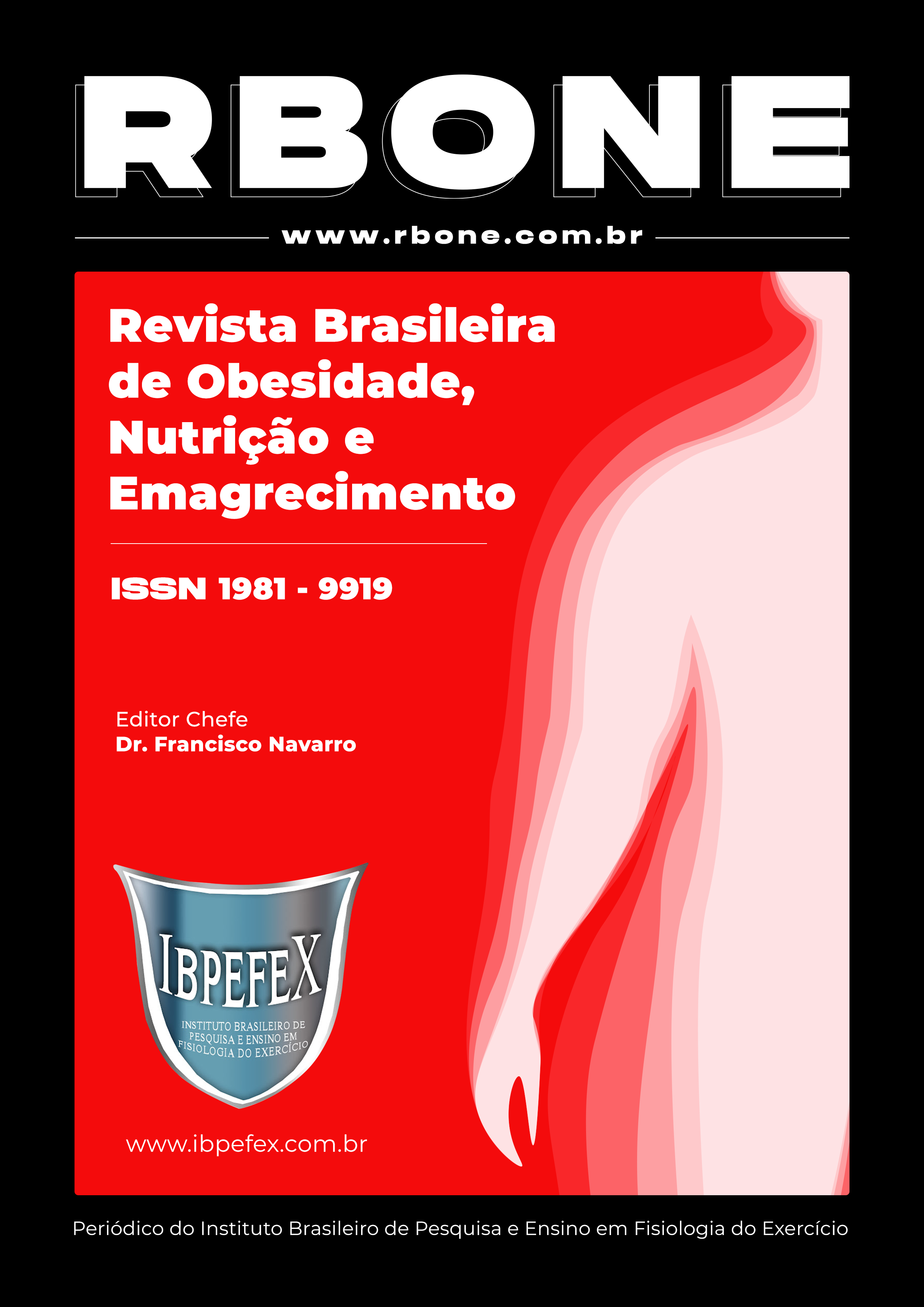Analysis of the nutritional status and flexibility by the sit and reach test in elementary school children in a school in Alto Vale do Itajaí
Abstract
Introducion: Flexibility (FLEX) is considered a physical ability that peaks in childhood and is considered of fundamental importance for performance in physical activity at any stage of life. Objective: to evaluate the FLEX in schoolchildren aged 6 to 11 years and compare it with recommended criteria for each age group, considering factors such as sex, age and nutritional status (NES). Materials and Methods: cross-sectional study that investigated children from a private school in the city of Rio do Sul-SC. We evaluated 45 children of both sexes. The variables mass and height were evaluated to obtain the body mass index (BMI). To evaluate FLEX, we used the sit and reach test with the Wells bench. For data analysis, the Statistical Package for the Social Sciences (SPSS) program was used. The Kolgomorov-Smirnov test was used to analyze the normality of the data and descriptive statistics. The significance level adopted was p<0.05. Results: The sample consisted of 62.2% boys (n=28) and 37.8% girls (n=17). Most of the participants had the FLEX level considered Very Good. Underweight and eutrophic individuals represented 77.8%, while overweight and obese individuals represented 22.2% of the sample. Considerations: it was found that individuals with eutrophic EN showed better values in the FLEX classification compared to overweight and obese individuals. We could verify that the older the age, the lower the FLEX. Thus, we concluded that overweight, obesity, and chronological age negatively interfere in the FLEX.
References
-Aleixo, E.D. Nível de flexibilidade de crianças em idade escolar da cidade de Quelimane (Moçambique). Rev Ensino de Ciências e Humanidades, Cidadania, Diversidade e Bem-estar. Ano 5. Vol. 5 Num. 1. 2021. p.141-159.
-Bavaresco, A.; Both, D.R.; Matheus, S.C; Peripolli, J. Análisis de la flexibilidad en niños de 6 a 12 años de los municipios de Sao Joao do Polesine e Silveira Martins-RS. Rev EFDeportes, 2011. Disponível em: <http://www.efdeportes.com/efd157/analise-da-flexibilidade-em-criancas.htm>.
-Behm, D.G.; Blazevich; A.J; Kay, A.D; McHugh, M. Acute effects of muscle stretching on physical performance, range of motion, and injury incidence in healthy active individuals: a systematic review. Applied Physiology. Nutrition, and Metabolism. Vol. 41. Num. 1. p. 1–11, 2016. Disponível em: <https://doi.org/10.1139/apnm-2015-0235>.
-Borges, R.S. Prevalência do sobrepeso e obesidade e níveis de flexibilidade em crianças de 7 a 9 anos de idade. Monografia do Curso de Fisioterapia. Universidade Regional do Noroeste do Estado do Rio Grande do Sul. 2011.
-Dantas, E.H.M. Alongamento e Flexionamento. 5ª edição. Rio de Janeiro. Shape. 2005.
-Farias, D.L.; Teixeira, T.G; Tibana, R.A.; Balsamo, S.; Prestes, J. A força de preensão manual é preditora do desempenho da força muscular de membros superiores e inferiores em mulheres sedentárias. Motricidade. Vol. 8. Num. 2. p. 624-629. 2012. Disponível em: <https://www.redalyc.org/pdf/2730/273023568074.pdf>.
-Galdino, F.F.S. Elongación y flexibilidad: un estudio sobre conceptos y diferencias. Rev EFDesporte, Buenos Aires. Año 17. Num 176. 2013.
-Gaya, A. Projetos de pesquisa científica e pedagógica: o desafio da iniciação científica. Belo Horizonte. Casa da Educação Física. 2016. 426p.
-Gaya, A.R.; Gaya, A.; Pedretti, A.; Mello, J. Projeto Esporte Brasil: Manual de medidas, testes e avaliações. 5ª edição. Porto Alegre: Universidade Federal do Rio Grande do Sul. 2021.
-Joaquim, A.G.; Santos, A.R.; Rosa, L.F. Correlação entre nível de flexibilidade e desempenho na agilidade em escolares de 7 a 10 anos: um estudo transversal. Revista Brasileira de Prescrição e Fisiologia do Exercício. São Paulo. Vol. 11. Num. 71. 2017. p. 997-1005, Disponível em: <https://dialnet.unirioja.es/servlet/articulo?codigo=6341727>.
-Maio, R.C.G.; Rafaela E. G. Silva, R.E.G.; Silva, A.C.; Elicker, E. Comparação entre os níveis de flexibilidade de crianças entre 7 e 10 anos de uma escola pública e uma particular do município de Porto Velho. Anais Seminário Nacional Educa. Vol. 1. Num. 1. 2010. Disponível em: <https://periodicos.unir.br/index.php/semanaeduca/article/view/133>.
-Mello, J. B. Aptidão Física Relacionada à Saúde de Crianças: Uma Proposta […]. Tese Doutorado em Ciências do Movimento Humano. Universidade Federal do Rio Grande do Sul, Escola de Educação Física. Porto Alegre-RS. 2020.
-Mussoi, T. D. Avaliação Nutricional na Prática Clínica. Rio de Janeiro: Guanabara Koogan. 2017.
-Ribeiro, C.C.A.; Abad, C.C.C.; Barros, R.V.; Neto, T.L.B. Nível de flexibilidade obtida pelo teste de sentar e alcançar a partir de estudo realizado na grande São Paulo. Rev Bras de Cineantropometria & Desempenho Humano. Vol. 12. Num. 6. 2010. p. 415-421. Disponível em: <https://doi.org/10.5007/1980-0037.2010v12n6p415>.
-Simão, R.; Lemos, A.; Salles, B.; Leite, T.; Oliveira, É.; Rhea, M.; Reis, V.M. The influence of strength, flexibility, and simultaneous training on flexibility and strength gains. J Strength Cond Res. Vol. 25. Num. 5. 2011. p. 1333-1338. Disponível em: <https://pubmed.ncbi.nlm.nih.gov/21386731/>.
-Wells, K.F.; Dillon, E.K. The sit and reach: a test of back and leg flexibility. Research Quarterly for Exercise and Sport, Washington. Num. 23. 1952. p. 115-118. Disponível em: <https://www.tandfonline.com/doi/abs/10.1080/10671188.1952.10761965>.
Copyright (c) 2023 Paulo Roberto Santos Lopes, Ágata Katerine Ledra, Almir João Ledra, Anelise Sonza

This work is licensed under a Creative Commons Attribution-NonCommercial 4.0 International License.
Authors who publish in this journal agree to the following terms:
- Authors retain the copyright and grant the journal the right of first publication, with work simultaneously licensed under the Creative Commons Attribution License BY-NC which allows the sharing of the work with acknowledgment of the authorship of the work and initial publication in this journal.
- Authors are authorized to enter into additional contracts separately for non-exclusive distribution of the version of the work published in this journal (eg, publishing in institutional repository or book chapter), with acknowledgment of authorship and initial publication in this journal.
- Authors are allowed and encouraged to post and distribute their work online (eg, in institutional repositories or on their personal page) at any point before or during the editorial process, as this can bring about productive change as well as increase impact and impact. citation of published work (See The Effect of Free Access).






